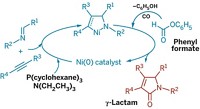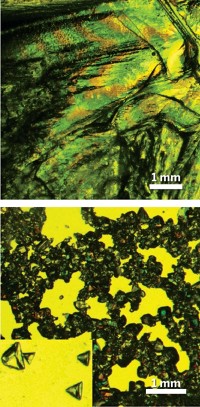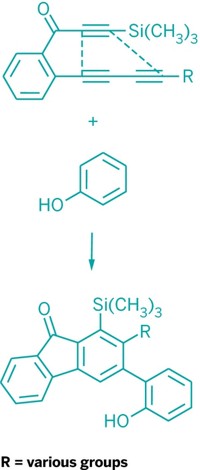Advertisement
Grab your lab coat. Let's get started
Welcome!
Welcome!
Create an account below to get 6 C&EN articles per month, receive newsletters and more - all free.
It seems this is your first time logging in online. Please enter the following information to continue.
As an ACS member you automatically get access to this site. All we need is few more details to create your reading experience.
Not you? Sign in with a different account.
Not you? Sign in with a different account.
ERROR 1
ERROR 1
ERROR 2
ERROR 2
ERROR 2
ERROR 2
ERROR 2
Password and Confirm password must match.
If you have an ACS member number, please enter it here so we can link this account to your membership. (optional)
ERROR 2
ACS values your privacy. By submitting your information, you are gaining access to C&EN and subscribing to our weekly newsletter. We use the information you provide to make your reading experience better, and we will never sell your data to third party members.
Synthesis
Science Concentrates
June 20, 2005
| A version of this story appeared in
Volume 83, Issue 25
Japanese researchers claim to have found the first quick and reversible method for converting a sol-gel between its liquid and solid phases (J. Am. Chem. Soc., published online June 11, dx.doi.org/10.1021/ja050809h). Takeshi Naota and Hiroshi Koori, chemists at Osaka University, dissolve a palladium complex (shown) in an organic solvent. A brief burst of ultrasound instantly converts the solution into a stable gel; heating transforms the gel back into a liquid. (See a movie of this.) The cycle can be repeated indefinitely. Naota and Koori find that ultrasound changes the molecular complex from a bent, clothespinlike conformation to a planar conformation. Unlike molecules in the bent conformation, those in the planar conformation interweave readily, forming first a dimer and then an extended stack. The researchers also discovered that gelation won't occur if the molecule is used in an optically pure form. Both enantiomers are required, it turns out, because they alternate to form the stack.
Delivering a drug combo
A new polymer therapeutic combines two different drugs on the same backbone. The combination therapy targets breast cancer with both hormone therapy and conventional chemotherapy. So far, the combination product has been tested only in cell culture. Mara J. Vicent, Ruth Duncan, and coworkers at Cardiff University, in Wales, attach aminoglutethimide, a hormone that prevents estrogen biosynthesis, and doxorubicin, a widely used treatment for breast cancer, to a polymer backbone made of N-(2-hydroxypropyl)methacrylamide (HPMA) (Angew. Chem. Int. Ed. 2005, 44, 4061). The linkers connecting the drugs to the polymer can be tailored to release the drugs from the backbone at different rates. The drug-release profiles from the polymer are different when the drugs share a backbone from when they are by themselves. The combination drug is much more active against breast cancer in cell culture than a conjugate of HPMA and doxorubicin that has already shown activity in trials in patients resistant to chemotherapy.
Ancient CO2 levels revealed
Studying molecules synthesized by ancient sea algae, scientists have found that atmospheric levels of the greenhouse gas carbon dioxide decreased dramatically during Earth's shift from an extremely warm climate millions of years ago to one that's now much cooler (Science, published online June 16, dx.doi.org/10.1126/science.1110063). A relationship between this Paleogene-period climate and atmospheric CO2 has been difficult to establish, but Yale University assistant geology and geophysics professor Mark Pagani and colleagues have now filled in a big piece of that CO2 record. They accomplished this by examining long-chain unsaturated ethyl and methyl ketones, or alkenones, produced by ancient sea algae and extracted from sea cores. The isotopic ratios of carbon in these molecules are affected by CO2 and thus can be used to establish past CO2 levels. The results indicate that, from 45 million to 25 million years ago, atmospheric CO2 dropped from 1,000-1,500 ppm to present-day levels of 200-300 ppm.
User-friendly alkali metals
Alkali metals can be violently reactive. Chemists have tried to control this reactivity by dispersing the metals in inert solids or in liquid ammonia, but have not met with great success outside the lab. A team of chemists at Michigan State University and start-up company SiGNa Chemistry led by James L. Dye and Michael Lefenfeld has now developed a method to absorb alkali metals into silica gel to form powders that are up to 60 mol % of the metal, making them safer and more practical for industrial applications (J. Am. Chem. Soc., published online June 14, dx.doi.org/10.1021/ja051786+). When sodium or a sodium-potassium alloy is heated above 150 C, the molten metal can be mixed with silica gel to form different types of powders ranging from metal-silica adducts to metal-silicon nanoparticles, depending on the temperature. The powders can be used in batch reactions or as reducing agents in pharmaceutical and petrochemical processes. They also can be reacted with water to produce hydrogen. SiGNa Chemistry initially plans to use the powders to power hydrogen fuel cells in portable electronic devices.
Biosynthetic route to prenylation
A bacterial enzyme that transfers a prenyl group to an aromatic natural product may provide a general biosynthetic route to regioselective prenylation of aromatic small molecules, according to scientists at the Salk Institute for Biological Studies, La Jolla, Calif. (Nature 2005, 435, 983). Many bioactive natural products contain isoprenoid chains of various lengths, collectively known as prenyl groups. Tomohisa Kuzuyama, Joseph P. Noel, and Stphane B. Richard now have characterized Orf2, an enzyme that attaches a 10-carbon prenyl group to a polyketide during the biosynthesis of the antioxidant naphterpin (shown). This enzyme has a novel barrel-like architecture and is unexpectedly promiscuous, Noel tells C&EN. In vitro, Orf2 can regiospecifically prenylate a diverse collection of hydroxyl-containing aromatic molecules. The team is now examining the factors that control which prenyl chain is used and where it's appended on the substrate. This information should guide the design of modified enzymes that can be used to alter the activity of natural products in bacteria, fungi, plants, and animals; to make rare prenylated natural products; and to carry out regioselective prenylation of aromatic chemicals, Noel says.







Join the conversation
Contact the reporter
Submit a Letter to the Editor for publication
Engage with us on Twitter